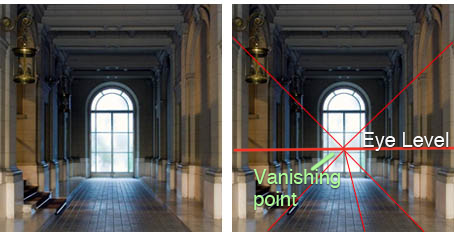Basic Perspective: Converging Lines
The edges of objects appear to converge or taper as they recede in the distance to a common point on the eye level or horizon line. In Linear Perspective this is referred to as a Vanishing Point.
Note: Converging lines are parallel in reality, but they appear to converge because of diminution. In art this is called “perspectively parallel.”
Examples
 Finding Eye Level/Horizon Line — Vanishing Point: The railroad tracks and the telephone poles all converge in the distance towards a vanishing point which is on the eye level/horizon line.
Finding Eye Level/Horizon Line — Vanishing Point: The railroad tracks and the telephone poles all converge in the distance towards a vanishing point which is on the eye level/horizon line.
Finding Eye Level — Vanishing Point: All of the parallel edges of stairs, columns, ceiling, etc. in the room point to the vanishing point which is on the horizon line/eye level.
In 1 point perspective, there is just one vanishing point, as shown in the examples above. For 2 point and 3 point perspective, there are two and three vanishing points, respectively. We refer to these points as VP1, VP2, and VP3.
VP1 — Vanishing point 1 is located on the eye level/horizon line and is to the left of your station point/line of sight.
VP2 — Vanishing point 2 is located on the eye level/horizon line and is to the right of your station point/line of sight.
VP3 — Vanishing point 3 is located above or below the eye level/horizon line and is at the station point/line of sight.
Note — In reality, all things we see are in 3 point perspective—that is, they all have a VP1, VP2, and a VP3.
